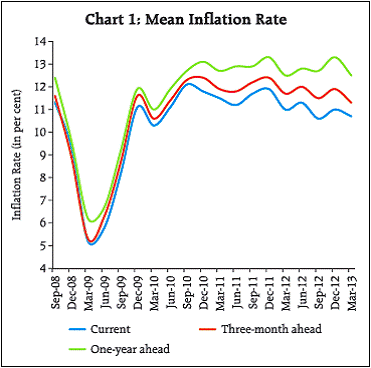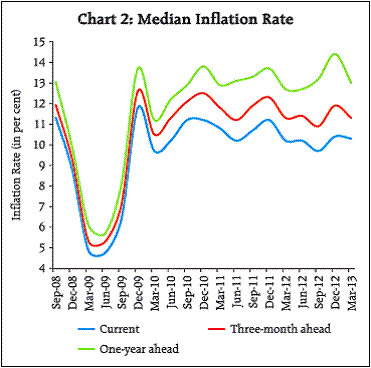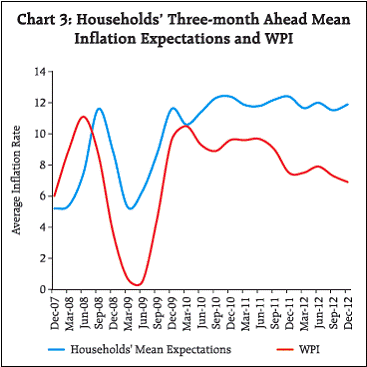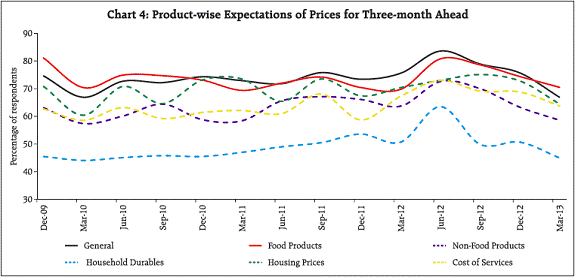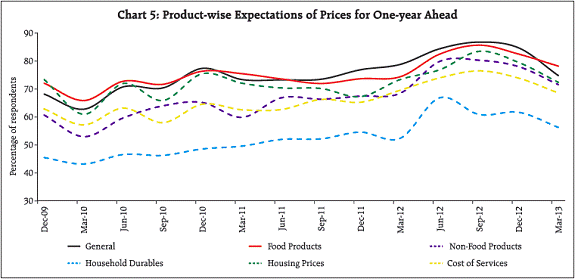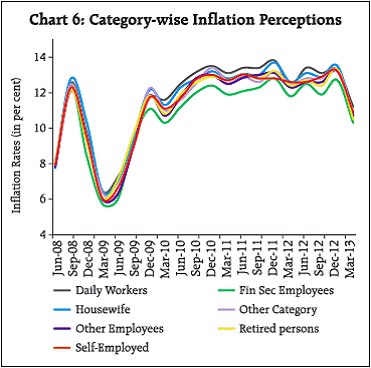Inflation Expectations Survey of Households: 2012-13 - આરબીઆઈ - Reserve Bank of India
Inflation Expectations Survey of Households: 2012-13
Inflation Expectations Survey of Households: 2012-13* Introduction The Reserve Bank has been conducting Inflation Expectations Survey of Households (IESH) on a quarterly basis, since September 2005. The survey elicits qualitative and quantitative responses for threemonth ahead and one-year ahead period on expected price changes and inflation. Inflation expectations of households are subjective assessments and are based on their individual consumption baskets and therefore, may be different from the official inflation numbers released periodically by the government. These inflation expectations should not be treated as forecast of any official measure of inflation, though they provide useful inputs on directional movements of future inflation. The quarterly survey results of IESH are released along with quarterly macro-economic and monetary development review on RBI website. This article presents analysis of survey results for longer-time, specially for last four (28th to 31st) rounds of the survey. 2. Sample Coverage and Information Sought Till September 2012 (29th round), the survey has been conducted in 12 cities. The major metropolitan cities, viz., Delhi, Kolkata, Mumbai and Chennai are represented by 500 households each, while another eight cities, viz., Jaipur, Lucknow, Bhopal, Ahmedabad, Patna, Guwahati, Bengaluru and Hyderabad are represented by 250 households each. From round 30, (quarter ended December 2012) four more cities have been added viz., Kolhapur, Nagpur, Thiruvananthapuram and Bhubaneswar. A sample of 250 households is selected from each of these cities so as to achieve a total sample size of 5,000 from 16 cities. The respondents having a view on perceived current inflation are well spread across the cities to provide a good geographical coverage, ensuring adequate representation of gender and occupation. The survey schedule is organised into seven blocks covering the respondent profile (block 1), general and product-wise price expectations (block 2 and 3), feedback on RBI’s action to control inflation (block 4), current and expected inflation rate (block 5), amount paid for purchase of major food items during last one month (block 6) and expectations on changes in income/wages (block 7). The response options for price changes are (i) price increase more than current rate, (ii) price increase similar to current rate, (iii) price increase less than current rate, (iv) no change in prices and (v) decline in prices. The inflation rates are collected in intervals - the lowest being ‘less than 1 per cent’ and the highest being ‘16 per cent and above’ with 100 basis points size for all intermediate classes. 3. Survey Results 3.1. Respondents’ Current Inflation Perception vis-à-vis Expectations The perception of current mean as well as median inflation and expectations of three month and one year ahead inflation rates are shown in Chart 1 and Chart 2. During the year 2012-13, the inflation perceptions as well as expectations for next threemonth were observed to be higher in Q1:2012-13 and Q3:2012-13 (June and Dec 2012 rounds) which declined in Q4:2012-13 (Table 2). The percentages of the respondents, perceiving current inflation and expecting future inflation in double digits, also decreased over the quarters during the year (Table 1). The mean and median inflations were observed to be range-bound during recent years. Also, it can be observed that future expectations of inflation move closely in tandem with the current perception of inflation. The time series movements of inflation expectations show that future expectations are comparatively higher than current perceptions. Thus, irrespective of whether it is a low inflation environment or high inflation environment, households tend to expect future inflation to be relatively higher than the perceived current rate. City-wise inflation expectations varied to some extent throughout the year 2012-2013. Age-wise and gender-wise inflation expectations were of similar pattern. The households' mean inflation expectations for next three-month and average WPI is presented in Chart 3. The households’ expectations remained higher than WPI inflation. While there is a difference in the level of inflation between the headline WPI and as observed through the survey, notably households’ three-month ahead inflation expectations have been tracking WPI turning points (ex-post) quite closely (Chart 3). This could be seen as the households’ inflation expectations are adaptive with significant learning (Mohanty 2012)1. 3.2. Movements of General Price Expectations for Three-Month Ahead and One-Year Ahead In all the four quarterly rounds of the survey during the year 2012-2013, about 98 per cent respondents expected increase in general prices for both three-month ahead and one-year ahead periods. About 70 per cent of respondents expected general price increase at more than current rate in both the periods till Q3:2012-13; however, the proportion decreased in Q4:2012-13. The percentage of respondents expecting general price increase at ‘more than current rate’ in both periods decreased from 73.3 per cent in Q1: 2012-13 to 59.3 per cent in Q4:2012-13. The cross-tabulation of general price expectation for three-months ahead and one-year ahead for the last four rounds are given in Table 3.1 to Table 3.4. Out of the respondents expecting ‘price increase at more than current rate’ for three-month ahead period, majority (more than 87 per cent) also expected the same for one-year ahead period for all the quarters. Product group-wise price expectations show that the general price expectations are consistently aligned with food price expectations than with other product groups. The trend is similar for both the periods threemonth ahead as well as one-year ahead expectations (Chart 4 & 5). 3.3. Identification of Major Source of Variation The variability in responses for current inflation perception and future inflation expectations may partly be explained by different classificatory factors viz., gender, age-group, city and occupational category of respondents over different rounds. An analysis of variance (ANOVA) over different rounds (Table 4) revealed that city has always been a significant source of variation in each round followed by occupational ‘category’. Other significant source of variation, along with city and category, for one-year ahead inflation expectations in Q1: 2012-13 and for three-month ahead inflation expectations in Q2: 2012-13 rounds, was gender. Age-group was also found to be a significant source of variation for current inflation in Q3: 2012-13 and one-year ahead inflation expectations in Q3: 2012- 13 and Q4: 2012-13 rounds along with city and category. 3.4. Income Perceptions vis-à-vis Inflation Perceptions The mean inflation perceptions/expectations for the three time-periods (current, three-month ahead and one-year ahead) for respondents perceiving income changes at various levels (increase, decrease and no change) is presented in Table 5. Respondents who reported an income increase in the last one year expected lower inflation rates as compared with those reporting decrease in income. Similarly, respondents expecting an income increase in the next one year expect lower inflation for all the three time-periods as compared with those expecting a fall in their income. 3.5. Awareness About RBI’s Role in Controlling Inflation and Respondents’ Inflation Perceptions The mean current inflation, inflation expectations for three-month ahead and one-year ahead for respondents who were aware of Reserve Bank of India’s role in controlling inflation are presented in Table 6. The current perceptions and future expectations of inflation of respondents having awareness about RBI’s action, are relatively lower than those of the respective overall inflation perceptions for all the four quarters of the year 2012-13. 3.6. Inflation Perceptions of Respondent According to Their Occupation Category Chart 6 indicates that respondents of various occupations show similar trend over quarters. Housewives and Daily workers reported the highest rates whereas Financial sector employees reported lowest inflation rate throughout the financial year 2012-13. 3.7. Bootstrap Confidence Interval for Estimates of Inflation Rates In order to evaluate the quality of estimates, the confidence interval for mean inflatio n perceptions have been estimated by bootstrap methodology. Based on 10,000 re-samples selected through ‘simple random sampling with replacement’, the 99 per cent bootstrap confidence intervals for mean inflation are given in Table 7. The narrow confidence intervals are indicative of the robustness of the estimates. The width of confidence intervals varied between 24 to 32 basis points. 3.8. Inter Consistency Between Response to Qualitative and Quantitative Questions The three-month ahead mean inflation expectation for those respondents who expected “general price increase more than current rate’’ in next three-month, was observed to be higher than their mean current inflation perception (Table 8). The difference between three-month ahead mean inflation expectations and current inflation has been very low for respondents who expected “general price increase similar to current rate” in next three months. The three-month ahead mean inflation expectation for those respondents who expected “general price increase less than current rate” was found to be less than current inflation perception. Similar observations can be drawn regarding one-year ahead period also. This establishes the consistency between qualitative and quantitative IESH data. 4. Conclusions Future inflation expectations remained higher than current inflation perceptions. Double-digit inflation expectations persisted throughout the financial year on an average. However, percentage of the respondents perceiving current inflation and expecting future inflation in double digits has declined over the quarters. City has been a significant source of variation for inflation perception captured through the survey. Annex-Data Tables
* Prepared in the Division of Household Surveys, Department of Statistics and Information Management. The 31st round of the survey data was released on May 2, 2013 on RBI Website. The survey schedule and description of the parameters on various product groups were published in November 2012 issue of the RBI Bulletin. The survey results are those of the respondents and are not necessarily shared by the Reserve Bank of India. 1The Importance of Inflation Expectations: Speech by Shri Deepak Mohanty, Executive Director, Reserve Bank of India at S.P. Jain Institute of Management & Research, Mumbai, November 9, 2012. |
|||||||||||||||||||||||||||||||||||||||||||||||||||||||||||||||||||||||||||||||||||||||||||||||||||||||||||||||||||||||||||||||||||||||||||||||||||||||||||||||||||||||||||||||||||||||||||||||||||||||||||||||||||||||||||||||||||||||||||||||||||||||||||||||||||||||||||||||||||||||||||||||||||||||||||||||||||||||||||||||||||||||||||||||||||||||||||||||||||||||||||||||||||||||||||||||||||||||||||||||||||||||||||||||||||||||||||||||||||||||||||||||||||||||||||||||||||||||||||||||||||||||||||||||||||||||||||||||||||||||||||||||||||||||||||||||||||||||||||||||||||||||||||||||||||||||||||||||||||||||||||||||||||||||||||||||||||||||||||||||||||||













